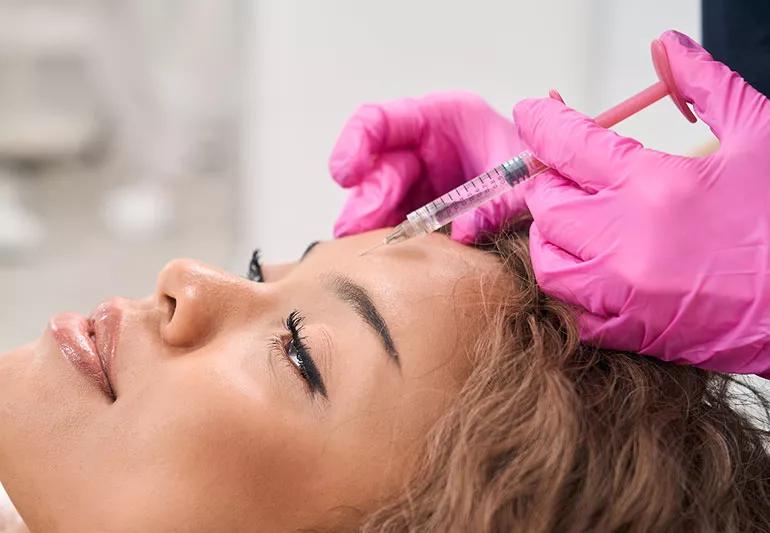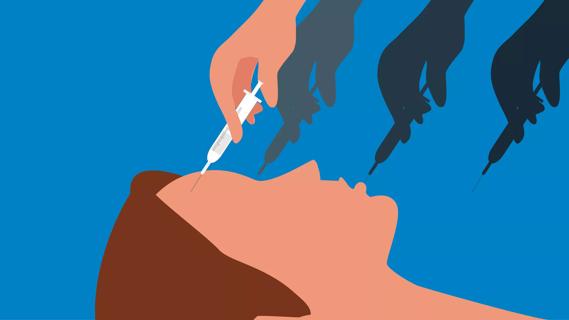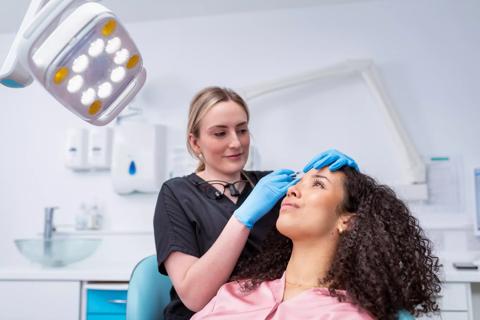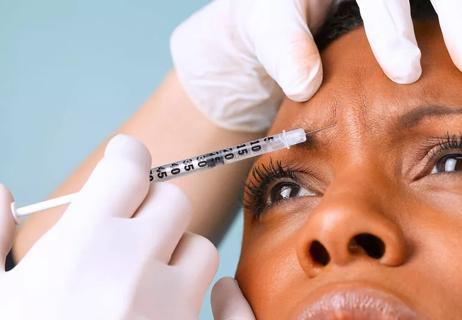One reduces wrinkles by relaxing muscles; the other adds volume and smooths skin

For every person who sees the folds, ridges and creases on their face as evidence of a life well-lived, there’s another person who looks at them with dismay. Wrinkles and fine lines are an inevitable part of getting older and beautiful in their own right. But that doesn’t mean you have to like them!
Advertisement
Cleveland Clinic is a non-profit academic medical center. Advertising on our site helps support our mission. We do not endorse non-Cleveland Clinic products or services. Policy
Plastic surgery is an option, but it’s expensive, invasive and can take a long time to heal. That’s why more and more people are turning to Botox® and dermal fillers to turn back the clock. But what are they exactly? And how can you tell which to get?
We talked to dermatologist Shilpi Khetarpal, MD, about neuromodulators and fillers — what makes them different, what kinds of wrinkles they’re used on and things to be aware of if you’re considering either procedure.
Botox and fillers may seem similar at first glance, but Dr. Khetarpal explains that they’re actually completely different.
Botox is a neuromodulator. To be more precise, it’s a purified form of clostridium botulinum bacteria. In far higher doses, botulinum toxin causes botulism. But in small doses, the neurotoxin blocks the nerves, causing the muscles injected to weaken.
While best known as a cosmetic procedure, Botox injections can also ease pain and help correct issues caused by muscular disorders. It’s common, for example, to get Botox for migraines, overactive bladder and pain caused by temporomandibular joint (TMJ) disorders.
There are actually several different brand-name injectable neuromodulators on the market that have a similar impact on wrinkles, including:
Advertisement
Unlike neuromodulators, which can have several uses, dermal fillers are strictly cosmetic. Think of them as liquid implants that are injected into your skin (not your muscles) to plump and smooth your facial features. Different brands of fillers use different synthetic materials, from hyaluronic acid to polymethylmethacrylate (PMMA). How long the filler lasts depends on what material your provider uses.
In some cases, a cosmetic dermatologist will use fat from another part of your body instead of a synthetic substance to fill your wrinkles — that’s called “autologous fat grafting.”
Not every wrinkle and fold should be treated the same way. That’s why Dr. Khetarpal says it’s common to receive both facial fillers and neuromodulators in one appointment. “Neurotoxins and filler are designed to do two different things,” she clarifies. To understand the difference, you should know that there are two main types of facial wrinkles:
Dynamic wrinkles are best treated with Botox or another neuromodulator. Dr. Khetarpal notes that the three most common treatment areas are in the upper face around the eyes, between the brows and the forehead.
Fillers are also used to treat volume loss in the lower face (like cheeks and smile lines). They can also be used to add fullness, like in sunken cheek bones or to plump up the lips.
Static wrinkles are often treated with both neuromodulators and filler. In these cases, Dr. Khetarpal explains, neurotoxins like Botox treat the underlying muscle, while the filler treats the lines at rest.
Both neuromodulators and dermal fillers are considered safe procedures, with less than 1% of patients experiencing significant side effects. Still, it’s important to be aware of the risks and possible side effects of any cosmetic procedure, so you can decide if they’re worth the potential results.
Most of Botox’s potential side effects are minor and temporary, lasting only a day or two. They include:
Advertisement
In rare cases, the following severe side effects have been observed:
It’s important to note that this list doesn’t cover the side effects and risks associated with Botox’s noncosmetic uses. If you have neuromuscular disorders like peripheral neuropathy or multiple sclerosis (MS), you should not get Botox or any other neuromodulator as it can cause symptoms to worsen.
As with neuromodulators, dermal fillers are generally safe. Most people don’t experience side effects, but those who do sometimes have to deal with them for a while.
Short-term complications of filler include:
Long-term complications are mostly aesthetic:
Advertisement
When it comes to filler, the biggest potential issue is an allergic reaction to whatever synthetic substance is injected. That’s why it’s important to watch for the following symptoms:
Another rare but serious side effect of dermal fillers is vision problems. If you have issues with your eyesight, along with weakness, discomfort or pain on one side of your body, Dr. Khetarpal says you should get immediate medical help.
In rare cases, poorly trained practitioners have accidentally injected filler material into a blood vessel, which can cause serious complications like stroke, tissue death or blindness. That’s why it’s important to always get dermal fillers from a qualified professional.
It’s also important to confirm that your healthcare provider is using a high-quality, medical-grade filler that doesn’t contain ingredients you’re allergic to.
Botox and dermal fillers are both nonsurgical cosmetic procedures that help reduce signs of aging, but the similarities stop there.
Botox is one of a range of neuromodulators on the market. These neurotoxins are injected into the facial muscle, relaxing it in a way that reduces dynamic wrinkles from facial movement.
Advertisement
Fillers are injected into the skin to plump and smooth static wrinkles.
But it’s common to get fillers and neuromodulators at the same time, as the two procedures target different areas of concern and work well together to reduce overall signs of aging.
Both procedures are generally considered safe, but — as with all procedures — come with some risks and potential side effects. A qualified professional should always inject Botox and fillers.
If you’re interested in learning more about neuromodulators, dermal fillers or both, Dr. Khetarpal recommends talking to a cosmetic specialist. They’ll help you decide what makes the most sense for you given your goals, budget and health status.
Learn more about our editorial process.
Advertisement

Although Botox isn’t an FDA-approved treatment for TMD pain, it’s still considered a good supplemental therapy in some cases

Most recommended precautions center around minimizing bruising or swelling

With repeat injections over time, you may be able to slow the development of new wrinkles

The cosmetic injection may help train your muscles out of frowning, but there’s no hard data to say for sure

The big difference with this procedure is the smaller dosing

It’s an FDA-approved treatment for urinary incontinence and overactive bladder

Both are used to treat fine lines and wrinkles

If you're tired of products that don’t stop your serious sweating, Botox could be life-changing

If you’re feeling short of breath, sleep can be tough — propping yourself up or sleeping on your side may help

If you fear the unknown or find yourself needing reassurance often, you may identify with this attachment style

If you’re looking to boost your gut health, it’s better to get fiber from whole foods